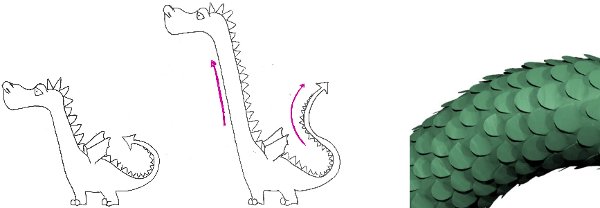Imagine Internships
Detail preserving deformations

Advisors
Stefanie Hahmann, IMAGINE teamMarie-Paule Cani, IMAGINE team
Damien Rohmer, IMAGINE team
Contact: marie-paule.cani@inrialpes.fr, stefanie.hahmann@inria.fr
Motivations
Being able to deform a 3D model intuitively and efficiently is an essential issue not only for interactive modeling applications but also for applications related to computer animation.
Nowadays deformation tools succeed in preserving repetitive details at different levels of resolution coherently. But these methods generally fail in case of local scale change, such as stretching or compression. In this case, the details undergo a scale change as well, which may destroy the natural morphology of the model. Stretching for example a tree trunk having some bark, a dinosaur wearing some salient chips, or a terrain composed of trees, would imply stretching of these details as well. In contrary, the user might expect that only the base shape is deformed while some of the repetitive details duplicate or vanish in case of compression, so that the global aspect of the model is conserved (see figure).
Goal
The method to be developed should first extract repetitive geometric features of functional details from the object to be deformed. It should set up representations and algorithms able to preserve those characteristics during non-isometric deformations. We are in particular interested in natural objects, in contrast to artificial (manmade) ones, which are much more regular and easier to handle.
The detail extraction method should adapt to the geometrical representation of the model. An implicit surface for example can be analyzed by reconstructing a hierarchical skeleton as a graph-type structure. A mesh-based representation can be decomposed into a base surface representing the global shape and a height field representing the details.
The distribution of size and space in-between the details may be used to develop a deformation method able to add details in case of stretching, or to remove details in case of compression, such that the properties of the initial distribution are preserved.
Particular attention should be paid to the preservation of dynamic continuity of appearance/removal of details [1] during deformation, so as not to disturb the user when sculpting the model.
